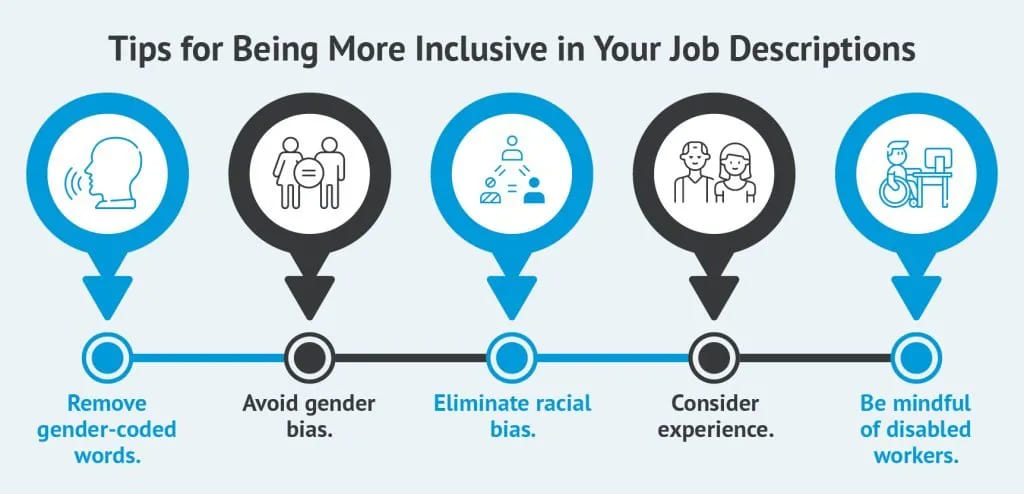
When candidates show up for an interview, their objective is to make a positive first impression on your hiring team. They aim to earn your respect and show their potential to succeed in the role they’ve applied for.
During the recruitment process, your company should strive to make a strong first impression on job seekers, starting with your job postings. Beyond listing the job title and qualifications, a solid job posting will convince people to apply for the role.
In this guide, we’ll provide tips on how to enhance your job postings, attract the right applicants, and encourage them to apply to your open positions.
1. Use clear language.
Like any type of communication, your job postings should feature clear, concise language that gets your message across—in this case, the open role and why people should apply. Keep your focus on informing applicants about the position in a way that’s easy to digest and answers questions that may arise.
Make your job postings easy to read and understand by:
- Avoiding jargon. Naturally, you may be tempted to include terms related to the job and industry. For example, a digital marketing agency hiring a search engine optimization (SEO) specialist may use acronyms like “SERP” and “CMS.” However, the average applicant may not be familiar with these concepts, especially if they come from a different professional background. Opt for a more universal language that everyone can understand.
- Implementing active voice. Since you’re describing what future employees will do at your company, active voice will be more impactful here. For example, saying employees “are sent data points to review” removes individual agency and action, whereas explaining employees “summarize and analyze relevant data” is clearer and more descriptive.
- Simplifying sentence structure. Long, jumbled sentences that may be appropriate in conversation or internal communications may confuse job seekers reading your job postings. Instead, use short, simple sentences that succinctly summarize your main points.
- Using bulleted lists. When listing role elements or qualifications, use bulleted lists. That way, you can break up the text and make it easy to skim the page.
Reading your job postings aloud is an effective way to catch confusing language or opportunities for increased clarification. Your ears can often catch mistakes or awkward wording that your eyes gloss over, allowing you to make your postings sound as natural as possible.
While the language you use should be clear, so should the fact that your specific company is hiring. Incorporate elements of your brand, such as your brand voice and logo, so applicants recognize the job posting as belonging to your business.
2. Emphasize all offered compensation types.
Of course, applicants want to know the expected salaries of the positions they’re applying for, and in some locations, sharing this information may be legally required. However, salary is likely only part of your overall compensation package.
Ensure you emphasize the various types of compensation your company offers to entice job seekers to apply. Your employee compensation package likely encompasses some or all of the following elements:
- Base salary or hourly pay, or the fixed amount you pay employees regularly
- Variable pay, like bonuses, incentives, and commissions, which typically depend on employee or company performance
- Long-term incentives meant to encourage employee retention, such as stock or stock options
- Benefits, such as health insurance, paid time off (PTO), retirement plans, and disability coverage
- Perks or extra rewards employees receive, like a new computer or access to professional development courses
When comparing different opportunities, job seekers often look at different employers’ compensation packages side by side. Prove why your organization is the best option and build trust with applicants by being transparent about all of the elements that go into the compensation package for your open role.
3. Be inclusive.
The way you talk about jobs at your company reflects how you envision the people filling these roles. Exclusive language may discourage people from applying and prevent you from accessing top talent.
To portray openness and encourage a more diverse candidate pool, Astron Solutions’ job description guide recommends implementing the following inclusivity best practices:

- Remove gender-coded words. Although you may not think of certain words as pertaining to a particular gender, they may evoke an unconscious association with one gender or another that discourages people from applying. For example, Astron cites words like “sensitive” and “affectionate” as female-coded and “aggressive” and “outspoken” as male-coded.
- Avoid gender bias. Studies show that men tend to apply for jobs where they meet only 60 percent of the qualifications, whereas women only apply when they meet 100 percent of the qualifications. This discrepancy can be addressed by specifying required versus preferred skills and emphasizing useful transferable skills.
- Eliminate racial bias. While racial bias can be implicit, there are steps you can take to eradicate racial bias in your job postings. For example, even if they’re fluent in English, non-native English speakers may be deterred by the phrase “strong English language skills.” Additionally, while employees should fit seamlessly into your work environment and culture, opt for terms like “value alignment” instead of “cultural fit,” which can have biased undertones.
- Consider experience. Young applicants may not have many years of work experience while older job seekers may be hesitant to apply to jobs since they’re close to retirement and not as familiar with new technology used in the workplace: center experience and potential to appeal to applicants of all ages.
- Be mindful of disabled workers. Lastly, encourage those with disabilities to apply by offering and listing sample accommodations your organization can provide.
In addition to the text within your job postings, other page elements should also be inclusive and accessible to all. For example, if you incorporate any images or videos into your job postings, ensure they have alternative text and closed captions so those with visual and hearing impairments can interpret this content.
4. Highlight your company culture.
According to eCardWidget, “47 percent of active job seekers are leaving their current jobs because of bad company culture,” which may entail anything from a culture of secrecy to poor work-life balance to a lack of support and trust. As much as prospective employees want to know if they’re right for the role itself, they also want to know what their overall experience working at your company would look like.
Help applicants gauge their value alignment with your company by showcasing your:
- Values. List your company’s core values so job seekers can determine whether these align with their personal values. For example, you may explain that your company celebrates collaboration and inquisitiveness in the workplace.
- Attitudes. Do employees show up each day eager and ready to work? Do they care deeply about the work that they do? Describing team members’ general attitudes can help applicants better understand the work environment.
- Practices. Lastly, note any company operations, policies, and procedures that contribute to company culture. For instance, you may demonstrate your commitment to giving back by listing your matching gift program or show that you encourage team camaraderie by mentioning that you host employee events.
To make your company culture come to life in your job postings, consider including testimonials, photos, or videos of actual employees showcasing their positive experiences at your company. Remember to ask for their permission before publicly sharing any content featuring their names or faces.
To improve your job postings further, constantly iterate on your strategy and survey applicants to get their perspective. Use their feedback to tweak the language and content of your job postings to ensure they’re clear, comprehensive, and inclusive for all.




